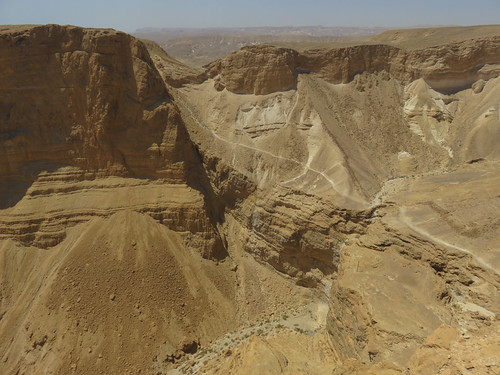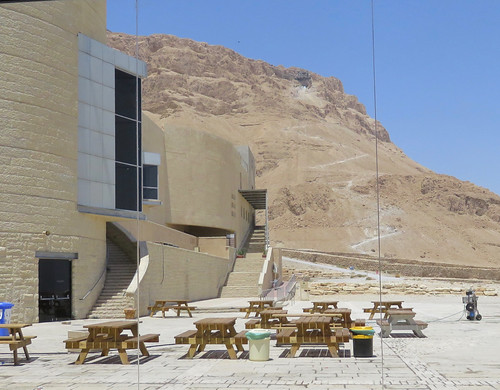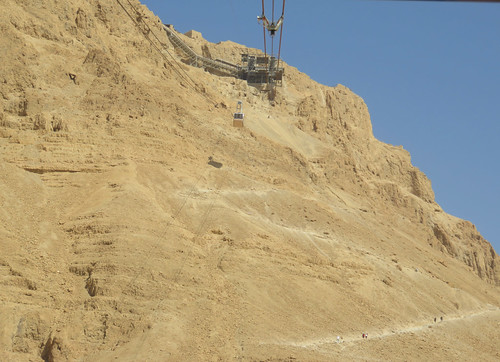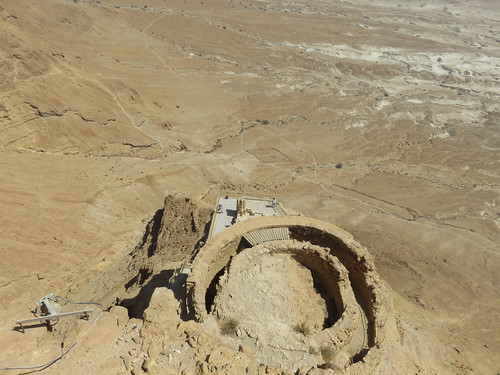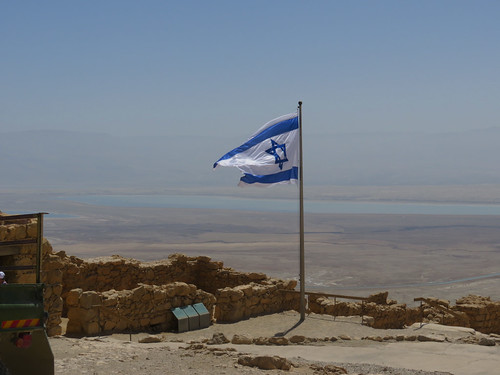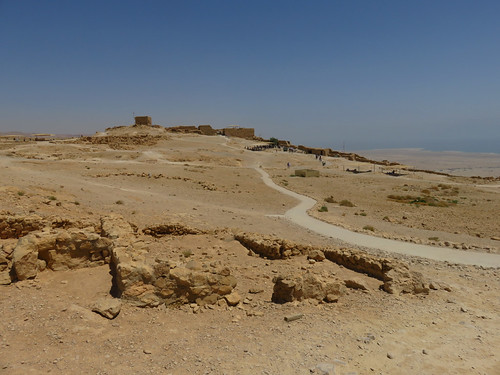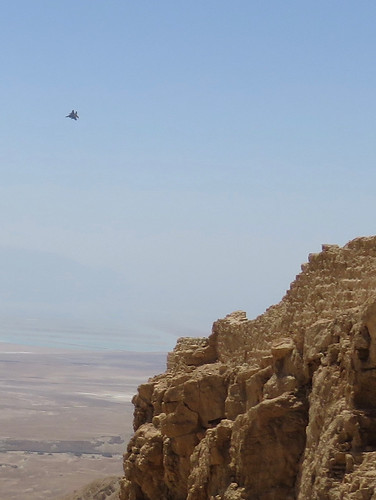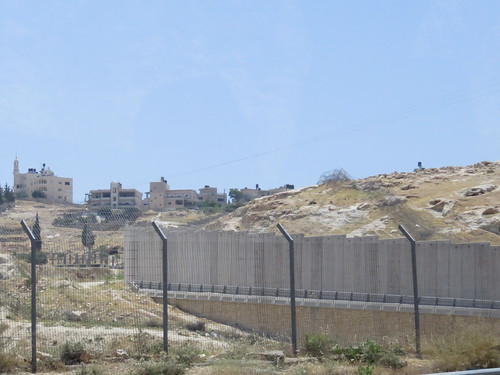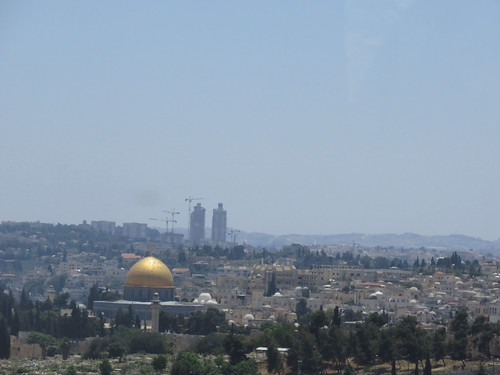Israel 2017–Day 7
The natural fortress of Masada stands apart from the escarpment of barren mountains that rise above the Dead Sea depression.
Our bus pulls up to the elegant visitor center at its base, all pavement and walls faced with the “Jerusalem stone” that seems both to reflect and absorb light in a warm blend reminding me of the travertine marble of the Getty Center in LA.
We wait briefly at a landing for a gondola sliding down the 1500 foot vertical drop from from the summit on a single-span cable and then are whisked upward, above the ancient snake path now being climbed by intrepid hikers. We exit the back of the landing station and walk a narrow trail carved into the vertical cliff face that joins the snake path at the stone gateway through the wall at the top and emerge onto a spacious plateau.
Everything in sight is the same color of the reddish tan bedrock. Gabi leads us up and across to the western edge, passing piles of rounded rocks stockpiled by the inhabitants to defend against attackers from below. She tells us the familiar story of this place.
It was built in the first century BCE by Herod the Great, who’s made his dominating presence in the history of Israel already felt in Caeserea. Neither a Jew nor a Roman, he succeeded in overthrowing the Jewish Hasmonean dynasty that had ruled for a couple of centuries since the successful Maccabean revolt against Hellenistic Greek rulers and nevertheless found a way to establish an ambitious Roman client regime accepted by most Jews. Herod was an effective politician, a megalomaniac builder, paranoid and brutal. Known as the tyrant who ordered the slaughter of the Innocents reported in Matthew’s gospel and who had his sons and wife murdered, he built several impressive cities for his own amusement and protection. Masada was intended as a retreat in case of revolt or attack, but it also served as an occasional party palace with fortifications, vast subterranean storage facilities and a water system that would allow it to survive a years-long siege.
Herod died peacefully in his bed in another of his grand cities, but Masada was taken over by a group of Zealots after the Romans crushed the Jewish rebellion and destroyed the second temple in 70 CE. The 900 members of this Jewish cult and their families held out for three years against the Roman siege. Then ten thousand Roman legionaires surrounded the place, the remnants of their camps and walls still evident, and eventually built a huge siege ramp leading up to the fortress.
The contemporary historian Josephus reported that the night before the end came in sight, the Zealots killed one another to avoid humiliation and defeat.
The discovery of and excavation of the ruins was led by Yael Yagdin, former general and archaeologist whose accomplishments are memorialized in the museum at the base. Many young Israelis participated voluntarily in those excavations, ceremonially climbing to the top via the snake path. At the end of their basic training period, all new members of the Israeli Defense Forces are still sworn in at the site.
There’s time to wander around unguided while the others go down to the gift shop.
On my way to the southern edge of the mesa to look down into the canyon, a couple of Israeli fighter planes put on a little airshow, perhaps in preparation for the U.S. President’s upcoming visit.
We continue north and west back through the West Bank on the way “up” to Jerusalem. Fortified fences again parallel the road, and as we ascend, the Jewish settlements on the hilltops become more prominent and expansive.
As we approach the city, we get a glimpse of the wall, and then we’re over the pass at the top of Mt. Scopus, where we are granted our first view of the Holy City.
On the hillside just below we stop at a facility where professional archaeologists join students, volunteers and tourists in processing spoil from an unauthorized excavation near the Western Wall of the Temple Mount. Buckets of dirt are dumped on a screened tray to be sprayed with a hose to wash off sand and mud. Two people to a tray comb the remains for tiny bits of pottery, bone, metal, and glass. Jan and I are thrilled to come up with what looks like a big glittery bead. The professional archaeologist identifies it as a piece of glass-making detritus from the Second Temple period and stashes it in his hoard.
Afterward the bus drives up and down steep slopes through East Jerusalem’s clogged traffic, homemade buildings piled upon one another and ubiquitous trash, along the Old City walls into downtown West Jerusalem–a modernistic metropolis filled with high-rise towers, high-end shopping malls, and wide pedestrian streets, all faced with the Jerusalem stone aglow in the westering sun.
We’re delivered to one of those high rises, the posh Herbert Samuel hotel, located within easy walking distance of the Old City’s Jaffa Gate. After a nap, Jan and I walk through narrow side streets lined with bars, art galleries, and a tattoo shop. We stop at a recommended fish restaurant, the Dolphin, and are welcomed to a sidewalk table by the young owner, fashionably dressed in jeans and black t-shirt displaying his physique. He pours us complimentary glasses of wine from the bottle that previous patrons had left half full on the table. As we sit drinking and taking in the hectic street life, I notice a big revolver tucked into his belt above the back pocket.

